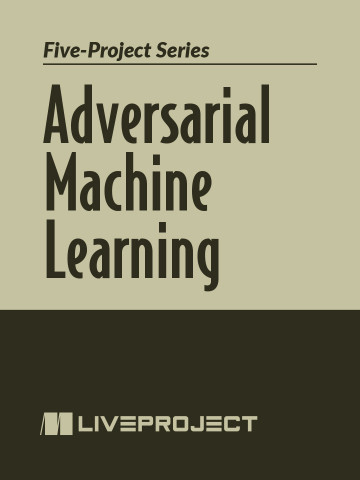- prerequisites
- intermediate Python (NumPy, array merging) • basics of CNN models • intermediate scikit-learn • intermediate Matplotlib • intermediate Keras/TensorFlow
- skills learned
- CNN model building with Keras • basics of untargeted adversarial attacks (FGSM, PGD) • attack generators (ART and CleverHans libraries) • basics of targeted adversarial attacks (PGD, BIM and Carlini & Wagner) • mitigation methods • adversarial training • defensive distillation basics
pro $24.99 per month
- access to all Manning books, MEAPs, liveVideos, liveProjects, and audiobooks!
- choose one free eBook per month to keep
- exclusive 50% discount on all purchases
- renews monthly, pause or cancel renewal anytime
lite $19.99 per month
- access to all Manning books, including MEAPs!
team
5, 10 or 20 seats+ for your team - learn more

Step into the realm of machine learning where adversarial attacks are a growing concern. In each of the liveProjects in this series, you’ll either play the role of an attacker penetrating a classification model or a cybersecurity professional protecting the model from malicious attacks. Using Convolutional Neural Network (CNN) architecture, you’ll build a deep learning model to predict patterns in images. You’ll generate untargeted and targeted adversarial ML attacks using the highly popular attack libraries CleverHans and Adversarial Robustness Toolbox (ART). Then, you’ll implement mitigation based on adversarial training and defensive distillation strategies. Throughout this series, you’ll gain firsthand experience on what goes into malicious ML attacks and building models to defend against them.
here's what's included

Tackle a fundamental step in many AI applications: building a simple image classification model. Using Convolutional Neural Network (CNN) layers, you’ll create this deep learning model for victims of adversarial machine learning attacks, train it on a publicly accessible traffic sign dataset, and implement it using Python.

Play the villain! Your goal is to mislead an existing DL model into incorrectly predicting the pattern. First, you’ll load your dataset, learn its structure, and examine a few random samples using OpenCV or Matplotlib. Using NumPy, you’ll prepare your dataset for training. Then, it’s attack time: Using FGSM and PGD, you’ll generate malicious inputs for the model in an effort to predict any class other than the correct one. Finally, you’ll enlist NumPy again to evaluate the success ratio of your attacks.

Mount a targeted attack! Your goal is to mislead an existing DL model into predicting a specific incorrect target class. First, you’ll load your dataset, learn its structure, and examine a few random samples using OpenCV or Matplotlib. Next, you’ll prepare your dataset for training using NumPy. Then you’ll generate malicious input using three different classes from the highly popular CleverHans attack library. Finally, you’ll enlist NumPy again to evaluate the success ratio of your attacks.

Protect your model by implementing adversarial training, the easiest method of safeguarding against adversarial attacks. You’ll load your dataset, learn its structure, and examine a few random samples using OpenCV or Matplotlib. Using Numpy, you’ll prepare your dataset for training, then you’ll use FGSM to generate malicious input for both untargeted and targeted attacks on a trained DL model. For each type of attack, you’ll evaluate your model before and after you apply adversarial training-based mitigation methods, gauging the success of your defense.

Make your model less vulnerable to exploitation with defensive distillation, an adversarial training strategy that uses a teacher (larger, more efficient) model to learn the critical features of a student (smaller, less efficient) model, then use the teacher model to improve the accuracy of the student model. In this liveProject, you’ll use a pre-trained model to train your student model without distillation, generate malicious input using FGSM, and evaluate the undefended model. Then, you’ll train a teacher model with a pre-trained dataset, train your student model with the same training set and teacher model using distillation, generate malicious input, and evaluate the defended student model, comparing the results with and without distillation.

team
- five seats for your team
- access to all Manning books, MEAPs, liveVideos, liveProjects, and audiobooks!
- choose another free product every time you renew
- choose twelve free products per year
- exclusive 50% discount on all purchases
- renews monthly, pause or cancel renewal anytime
- renews annually, pause or cancel renewal anytime
-
![]() Adversarial Machine Learning project for free
Adversarial Machine Learning project for free
Prerequisites
This liveProject series is for intermediate Python programmers who know the basics of data science. To begin this series, you’ll need to be familiar with the following:
TOOLS- Intermediate Python (file processing, data frames, data processing)
- Basics of Jupyter Notebook
- Basics of Matplotlib
- Basics of scikit-learn
- Basics of Keras/TensorFlow
- Basic NumPy
- Basic knowledge of neural networks
- Basic concepts in machine learning
- Basic data visualization
 features
features
- Self-paced
- You choose the schedule and decide how much time to invest as you build your project.
- Project roadmap
- Each project is divided into several achievable steps.
- Get Help
- While within the liveProject platform, get help from fellow participants and even more help with paid sessions with our expert mentors.
- Compare with others
- For each step, compare your deliverable to the solutions by the author and other participants.
- book resources
- Get full access to select books for 90 days. Permanent access to excerpts from Manning products are also included, as well as references to other resources.



 Adversarial Machine Learning project for free
Adversarial Machine Learning project for free